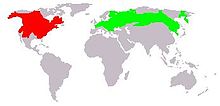Muskrat
| Muskrat Temporal range: Recent |
|
|---|---|
 |
|
| A muskrat foraging near a spring at Onondaga Cave State Park in Missouri | |
| Scientific classification | |
| Kingdom: | Animalia |
| Phylum: | Chordata |
| Class: | Mammalia |
| Order: | Rodentia |
| Superfamily: | Muroidea |
| Family: | Cricetidae |
| Subfamily: | Arvicolinae |
| Tribe: |
Ondatrini Gray, 1825 |
| Genus: |
Ondatra Link, 1795 |
| Species: | O. zibethicus |
| Binomial name | |
|
Ondatra zibethicus (Linnaeus, 1766) |
|
 |
|
| Muskrat ranges: Native in red, introduced in green, introduced range in South America not shown | |
The muskrat (Ondatra zibethicus), the only species in genus Ondatra and tribe Ondatrini, is a medium-sized semiaquatic rodent native to North America, and is an introduced species in parts of Europe, Asia, and South America. The muskrat is found in wetlands over a wide range of climates and habitats. It has important effects on the ecology of wetlands, and is a resource of food and fur for humans.
The muskrat is the largest species in the subfamily Arvicolinae, which includes 142 other species of rodents, mostly voles and lemmings. Muskrats are referred to as "rats" in a general sense because they are medium-sized rodents with an adaptable lifestyle and an omnivorous diet. They are not, however, members of the genus Rattus.
The muskrat's name probably comes from a word of Algonquian (possibly Powhatan) origin, muscascus (literally "it is red", so called for its colorings), or from the Abenaki native word mòskwas, as seen in the archaic English name for the animal, musquash. Because of the association with the "musky" odor, which the muskrat uses to mark its territory, and its flattened tail, the name became altered to musk-beaver; later it became muskrat due to its resemblance to rats.
Similarly, its specific name zibethicus means ‘musky’, being the adjective of ‘civet musk; civet’. The genus name comes from the Huron word for the animal, ondathra, and entered New Latin as Ondatra via French.
...
Wikipedia

